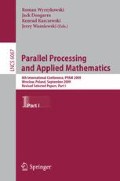Abstract
The method of the numerical solution of the time and rigidity dependent three dimensional (3-D) second order partial differential equation describing the anisotropic diffusion of the galactic cosmic ray particles in the heliosphere is proposed. A good agreement between the results of the numerical solution and experimental data is demonstrated. The proposed numerical method gives a broad possibility for implementation of the parallel programming techniques, and could be successfully used to solve second order partial differential equations, among them equations describing different classes of galactic cosmic ray intensity variations observed due to anisotropic diffusion of the galactic cosmic ray particles in the heliosphere.
Access this chapter
Tax calculation will be finalised at checkout
Purchases are for personal use only
Preview
Unable to display preview. Download preview PDF.
References
Parker, E.N.: Dynamics of the Interplanetary Gas and Magnetic Fields. Astrophys. J. 128, 664 (1958)
Jokipii, J.R., Thomas, B.: Effects of drift on the transport of cosmic rays. IV - Modulation by a wavy interplanetary current sheet. Astrophysical Journal, Part 1 243, 1115–1122 (1981)
Stone, E.C., Cummings, A.C., McDonald, F.B., et al.: Voyager 1 Explores the Termination Shock Region and the Heliosheath Beyond. Science 309, 2017 (2005)
Forbush, S.: World-Wide Cosmic-Ray Variations 1937-1952. Journal of Geophysical Research 59, 525 (1954)
Alania, M.V., Wawrzynczak, A., Bishara, A.A., et al.: Three Dimensional Modeling of the Recurrent Forbush Effect of Galactic Cosmic Rays. In: Proceedings 29th International Cosmic Ray Conference, Pune, India SH 2.6, vol. 1, pp. 367–370 (2005)
Krymski, G.F.: Diffusion mechanism of daily variation of galactic cosmic ray. Geomagnetism and Aeronomy 4(6), 977–986 (1964)
Parker, E.N.: The passage of energetic charged particles through interplanetary space. Planetary and Space Science 13, 9 (1965)
Axford, W.I.: Anisotropic diffusion of solar cosmic rays. Planet. Space Sci. 13, 115 (1965)
Gleeson, L.J., Axford, W.I.: Solar Modulation of Galactic Cosmic Rays. Astrophys. J. 149, 115–118 (1968)
Dolginov, A.Z., Toptygin, I.N.: Cosmic rays in the interplanetary magnetic fields. Ikarus 8(1-3), 54–60 (1968)
Jokipii, J.R.: Cosmic-Ray Propagation. I. Charged Particles in a Random Magnetic Field. Astrophysical Journal 146, 480 (1966)
Zhang, M.: A Markov Stochastic Process Theory of Cosmic-Ray Modulation. Astrophys. J. 513(1), 409–420 (1999)
Webber, W.R., Lockwood, J.A.: Voyager and Pioneer spacecraft measurements of cosmic ray intensities in the outer heliosphere: Toward a new paradigm for understanding the global modulation process: 2. Maximum solar modulation (1990-1991). J. Geophys. Res. 106(9), 323 (2001)
Caballero-Lopez, R.A., Moraal, H.: Limitations of the force field equation to describe cosmic ray modulation. J. Geophys. Res. 109, A01101 (2004)
Alania, M.V., Dzhapiashvili, T.V.: The Expected Features of Cosmic Ray Anisotropy due to Hall-Type Diffusion and the Comparison with the Experiment. In: 16th International Cosmic Ray Conference, vol. 3(80), p. 19 (1979)
Alania, M.V.: Stochastic Variations of Galactic Cosmic Rays. Acta Physica Polonica B 33(4), 1149–1165 (2002)
Kincaid, D., Cheney, W.: Numerical Analysis. WNT, Warsaw (2006)
Alania, M.V., Wawrzynczak, A.: On Peculiarities of The Anisotropic Diffusion During Forbush Effects of Galactic Cosmic Rays. Acta Phys. Polonica B 35(4), 1551–1563 (2004)
Wawrzynczak, A., Alania, M.V.: Peculiarities of galactic cosmic ray Forbush effects during October-November 2003. Adv. in Space Res. 35, 682 (2005)
Wawrzynczak, A., Alania, M.V., Modzelewska, R.: Features of the Rigidity Spectrum of Galactic Cosmic Ray Intensity during the Recurrent Forbush Effect. Acta Phys. Polonica B 37(5), 1667–1676 (2006)
Wawrzynczak, A., Alania, M.V.: Modeling of the recurrent Forbush effect of the galactic cosmic ray intensity and comparison with the experimental data. Adv. in Space Res. 41, 325–334 (2008)
Author information
Authors and Affiliations
Editor information
Editors and Affiliations
Rights and permissions
Copyright information
© 2010 Springer-Verlag Berlin Heidelberg
About this paper
Cite this paper
Wawrzynczak, A., Alania, M.V. (2010). Numerical Solution of the Time and Rigidity Dependent Three Dimensional Second Order Partial Differential Equation. In: Wyrzykowski, R., Dongarra, J., Karczewski, K., Wasniewski, J. (eds) Parallel Processing and Applied Mathematics. PPAM 2009. Lecture Notes in Computer Science, vol 6067. Springer, Berlin, Heidelberg. https://doi.org/10.1007/978-3-642-14390-8_12
Download citation
DOI: https://doi.org/10.1007/978-3-642-14390-8_12
Publisher Name: Springer, Berlin, Heidelberg
Print ISBN: 978-3-642-14389-2
Online ISBN: 978-3-642-14390-8
eBook Packages: Computer ScienceComputer Science (R0)

